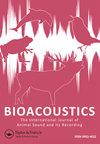游戏发声与人类笑声:比较回顾
IF 2.1
4区 生物学
Q2 ZOOLOGY
Bioacoustics-The International Journal of Animal Sound and Its Recording
Pub Date : 2021-04-19
DOI:10.1080/09524622.2021.1905065
引用次数: 18
摘要
复杂的社会游戏在许多动物中都有充分的记录。在游戏过程中,动物经常使用信号来促进有益的互动,减少潜在的代价,比如升级为攻击。虽然视觉游戏信号被给予了更多的关注,但在这里,我们证明了发声构成了跨物种的一种广泛的游戏信号模式。我们的研究表明,发声信号通常是不明显的,尽管人类和其他一些物种都存在大声发声,这表明它们具有广播功能。在许多物种中,人类自发的笑声与玩耍时发出的声音具有相同的声学和功能特征,但最明显的是其他类人猿。灵长类动物和其他哺乳动物在玩耍时发出的声音通常包括喘气的声音,这支持了人类笑声是从玩耍时呼吸困难的听觉提示进化而来的理论。人类社会的复杂性使笑声从一种特定于游戏的声音演变成一种复杂的实用信号,在群体内部和群体间环境中与大量其他多模态社会行为相互作用。这一综述为对不同类群的游戏发声进行详细的比较分析提供了基础,这可以揭示人类笑声的形式和功能,进而帮助我们更好地理解人类社会互动的进化。本文章由计算机程序翻译,如有差异,请以英文原文为准。
Play vocalisations and human laughter: a comparative review
ABSTRACT Complex social play is well-documented across many animals. During play, animals often use signals that facilitate beneficial interactions and reduce potential costs, such as escalation to aggression. Although greater focus has been given to visual play signals, here we demonstrate that vocalisations constitute a widespread mode of play signalling across species. Our review indicates that vocal play signals are usually inconspicuous, although loud vocalisations, which suggest a broadcast function, are present in humans and some other species. Spontaneous laughter in humans shares acoustic and functional characteristics with play vocalisations across many species, but most notably with other great apes. Play vocalisations in primates and other mammals often include sounds of panting, supporting the theory that human laughter evolved from an auditory cue of laboured breathing during play. Human social complexity allowed laughter to evolve from a play-specific vocalisation into a sophisticated pragmatic signal that interacts with a large suite of other multimodal social behaviours in both intragroup and intergroup contexts. This review provides a foundation for detailed comparative analyses of play vocalisations across diverse taxa, which can shed light on the form and function of human laughter and, in turn, help us better understand the evolution of human social interaction.
求助全文
通过发布文献求助,成功后即可免费获取论文全文。
去求助
来源期刊
CiteScore
4.50
自引率
0.00%
发文量
25
审稿时长
>12 weeks
期刊介绍:
Bioacoustics primarily publishes high-quality original research papers and reviews on sound communication in birds, mammals, amphibians, reptiles, fish, insects and other invertebrates, including the following topics :
-Communication and related behaviour-
Sound production-
Hearing-
Ontogeny and learning-
Bioacoustics in taxonomy and systematics-
Impacts of noise-
Bioacoustics in environmental monitoring-
Identification techniques and applications-
Recording and analysis-
Equipment and techniques-
Ultrasound and infrasound-
Underwater sound-
Bioacoustical sound structures, patterns, variation and repertoires

 求助内容:
求助内容: 应助结果提醒方式:
应助结果提醒方式:


